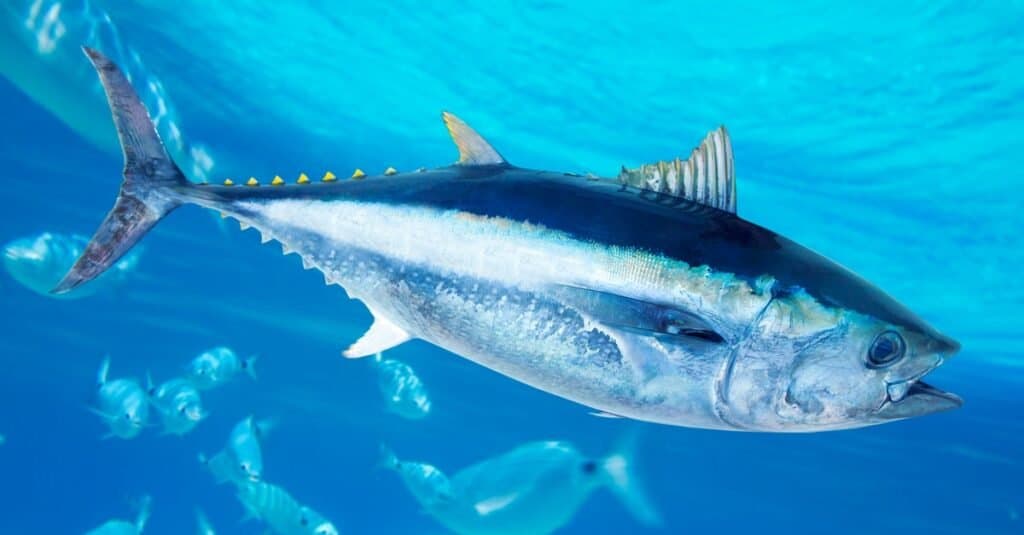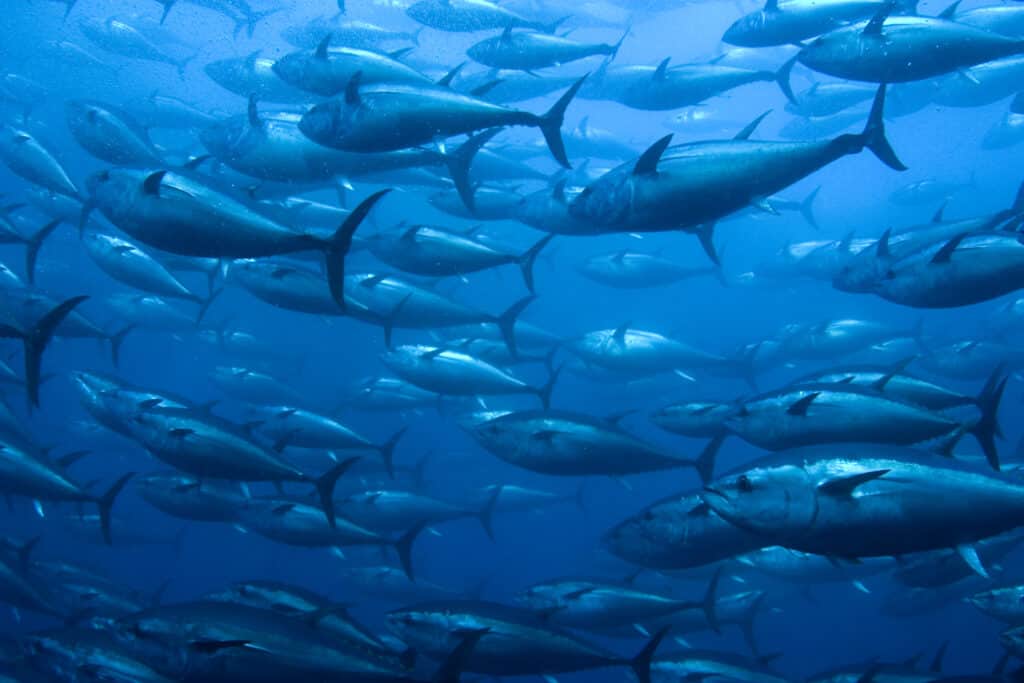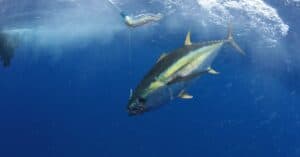Bluefin tuna is a highly prized and iconic fish species that has captured the imagination of people worldwide.
In Alabama, these fish are important to the Gulf of Mexico‘s ecosystem. They also have significant cultural, economic, and ecological importance.
Despite their value, bluefin tuna populations in Alabama and other parts of the world have been severely depleted due to the following:
- Overfishing
- Habitat destruction
- Pollution
- Climate change
Therefore, their conservation is crucial to preserve the health of the Gulf ecosystem and the well-being of local communities that rely on it.
This article discovers the largest bluefin tuna ever caught in Alabama. We also provide an overview of its physical characteristics, history, current state, diet, cultural significance, and the threats it faces.
What Is the Largest Bluefin Tuna Ever Caught in Alabama?
The largest Bluefin tuna ever caught in Alabama weighed 829 lbs. 6 oz. Angler John Engquist, a Baton Rouge, LA resident, caught the fish on June 3, 2006.
The Largest Bluefin Tuna Ever Caught Worldwide
The world’s largest bluefin tuna ever caught was an Atlantic bluefin tuna that weighed 1,496 lbs. This massive fish was caught off the coast of Nova Scotia, Canada, in October 1979 by angler Ken Fraser. The fish was 12 ft. long with a girth of 9 ft.
Bluefin tuna is an endangered species, and many countries have strict regulations to protect them. As such, catching such large specimens is now extremely rare and often prohibited or heavily regulated.
Physical Characteristics of Bluefin Tuna
Bluefin tuna are large, powerful, and highly migratory fish with impressive physical characteristics. These characteristics make them a remarkable and impressive species that has captured the attention of scientists, anglers, and seafood lovers worldwide. Here are some of the key features of bluefin tuna.
Size and Weight
Bluefin tuna are among the largest tuna species. Adults are typically 6-10 ft. long and weigh 400-1,500 lbs. Some reports suggest that bluefin tuna can grow up to 14 ft. long and weigh over 2,000 lbs., although such specimens are rare.
Coloration and Markings
Bluefin tuna have a distinctive appearance with:
- A dark blue-black upper body
- A metallic silver-white belly
- Iridescent blue-green or purple hues on their sides
They also have numerous black and yellow finlets that extend from the dorsal and ventral fins.
Anatomy and Physiology
Bluefin tuna have a streamlined, bullet-shaped body designed for speed and power. In addition, they have a deeply forked tail, providing them with excellent maneuverability and propulsion. Their muscles are very performant, allowing them to swim at up to 50 mph.
Unique Adaptations for Survival
Bluefin tuna have several unique adaptations that allow them to survive in their oceanic environment.
For example, they can regulate their body temperature to maintain a higher core temperature than the surrounding water. This enables them to swim faster and more efficiently. They also have a unique circulatory system that allows them to conserve heat and oxygen and prevent muscle fatigue during long migrations.

Bluefin tuna have a streamlined, bullet-shaped body designed for speed and power.
©lunamarina/Shutterstock.com
The History of Bluefin Tuna in Alabama
The history of bluefin tuna in Alabama dates back to the 19th century. That’sThat’sthe species was first caught in the Gulf of Mexico. But as commercial fishing for bluefin tuna increased, concerns about overfishing and the decline of populations led to the development of management plans and regulations.
Early Presence of Bluefin Tuna in Alabama
Bluefin tuna has been a part of Alabama’s ecosystem for centuries, with reports of the species being caught in the Gulf of Mexico dating back to the 1800s. Local communities relied on the fish as a food and income source. They quickly became an important cultural symbol for the state.
Management of Bluefin Tuna Over Time
In the mid-20th century, commercial fishing for bluefin Tuna increased, and concerns began to grow about overfishing and the decline of the species populations. In response, management plans and regulations were developed, including:
- Size and bag limits
- Seasonal closures
- The establishment of fishing quotas
Changes in Fishing Regulations
In recent years, fishing regulations for bluefin tuna have become stricter, reflecting growing concerns about the species. These regulations include tighter quotas, more exact sizing, and bag limits. Implementing a tagging program to monitor fishing activity and ensure compliance with regulations.
Environmental Factors Affecting Bluefin Tuna
In addition to fishing pressure, environmental factors also contribute to the decline of bluefin tuna populations. These include:
- Changes in ocean temperature
- Habitat loss due to coastal development and pollution
- The impact of climate change on the species’ food sources
The Current State of Bluefin Tuna in Alabama
Bluefin tuna populations in Alabama have fluctuated over the years due to various factors such as:
- Fishing pressure
- Environmental changes
- Natural variability
This tuna species remains vulnerable to overfishing and other threats despite efforts to protect it.
Bluefin Tuna Populations in Alabama
According to the National Marine Fisheries Service (NMFS), the Gulf of Mexico’s tuna populations have declined since the 1970s, with a significant decrease in the past decade.
The NMFS estimates that the current population is around 26% of the maximum sustainable yield, which is the level at which the population can be maintained over the long term without overfishing.
Recent Changes and Trends
There have been some positive signs for bluefin tuna populations in Alabama recently.
For example, in 2019, the NMFS announced that the annual quota for bluefin tuna in the Gulf of Mexico had been increased to 2.3 million lbs., up from 1.8 million lbs. the previous year.
This was due to an improvement in the overall bluefin tuna population in the Gulf. But the increase in quota also raised concerns among some conservationists that it could lead to overfishing and further harm to the population.

Bluefin tuna species remain vulnerable to overfishing and other threats despite efforts to protect them.
©iStock.com/DeepAqua
Threats to Bluefin Tuna in Alabama
Bluefin tuna face various threats to their survival in Alabama, including
- Overfishing
- Habitat destruction
- Pollution
- Climate change
These threats have contributed to population declines and highlight the need for conservation efforts.
Overfishing
Overfishing has significantly threatened bluefin tuna in Alabama.
Commercial fishing for the species has increased in recent decades, driven by demand for the fish in international markets. This has led to concerns about the sustainability of the population and the need for management plans and regulations to protect the species.
Habitat Destruction
Habitat destruction is another threat to bluefin tuna in Alabama. The species relies on healthy and diverse ecosystems for feeding and spawning, including:
- Seagrass beds
- Coral reefs
- Other coastal habitats
Development, pollution, and other human activities are increasingly threatening the bluefin tuna’s habitats.
Pollution
Pollution is also a significant threat to bluefin tuna in Alabama. The species can be exposed to various pollutants, including oil spills, plastic debris, and chemical contaminants, which can harm their health and impact their reproductive success.
Climate Change
Climate change is a growing concern for bluefin tuna in Alabama and other parts of the world. Rising sea temperatures, changes in weather patterns, and ocean currents can impact the abundance and distribution of prey species and the timing of spawning and migration for bluefin tuna.
Bluefin Tuna Diet in Alabama
Bluefin tuna are opportunistic predators that feed on various prey species, ranging from small planktonic organisms to large fish and squid. Various factors influence their diet, including:
- The availability and distribution of prey
- The size, age, and physiological condition of the individual fish
In Alabama’s ecosystem, bluefin tuna feed on a range of prey species, including:
- Fish
- Squid
- Crustaceans
Fish
Bluefin tuna prey on various fish species, such as:
The prey species are abundant in the Gulf of Mexico and the western Atlantic. They use their sharp teeth and powerful jaws to capture and consume their prey, often swallowing them whole.
Squid
Bluefin tuna also feed on squids, which are abundant in the Gulf of Mexico and the western Atlantic. They use their sharp teeth and powerful jaws to capture and consume squid, often breaking them into smaller pieces before swallowing.
Crustaceans
Bluefin tuna are opportunistic predators that also feed on various crustaceans, such as:
These crustaceans are abundant in the Gulf of Mexico and the western Atlantic. They use their sharp teeth and powerful jaws to crush the shells of crustaceans and extract their flesh.
Bluefin Tuna Predators
Despite their large size and powerful swimming abilities, bluefin tuna aren’t immune to predation. The species has several natural predators that hunt and feed on them. Here are some of the key predators of Bluefin Tuna.
Sharks
Bluefin tuna are preyed upon by a variety of shark species, including:
These sharks are fast and powerful swimmers. They can catch bluefin tuna in open water, using their sharp teeth and jaws to bite and consume them.
Killer Whales
Killer whales, also known as orcas, are another major predator of Bluefin Tuna. These intelligent and social marine mammals hunt in groups and can coordinate their attacks to take down large prey like bluefin tuna.
They use their sharp teeth and strong jaws to grip and tear apart their prey, consuming them whole or in large pieces.
Seabirds
Some seabird species, such as gulls and terns, feed on bluefin tuna.
These birds usually feed on scraps and leftovers from other predators, such as sharks and killer whales. But they can also hunt and catch bluefin tuna on their own.

Great white sharks can catch bluefin tuna in open water, using their sharp teeth and jaws to bite and consume them.
©Vincent Legrand/Shutterstock.com
The Cultural Significance of Bluefin Tuna in Alabama
Bluefin tuna are deeply embedded in local culture and traditions, celebrated through festivals, art, music, and other forms of cultural expression. Here are some of the key aspects of the cultural significance of bluefin tuna in Alabama.
Importance of Bluefin Tuna in Local Culture and Traditions
Bluefin tuna have played an important role in the cultural heritage of Alabama, especially for coastal communities. For generations, they’ve relied on the species for food, trade, and livelihoods. The species has been celebrated in local folklore, songs, and stories.
Celebrations and Festivals
Bluefin tuna are celebrated through various festivals and events throughout the year in Alabama and other parts of the Gulf of Mexico. These festivals feature live music, seafood dishes, and other cultural activities that honor the history and traditions associated with bluefin tuna.
Art, Music, and Other Cultural Expressions
Bluefin tuna have inspired a wide range of cultural expressions in Alabama, including:
- Paintings
- Sculptures and other forms of visual art
- Music and other performance arts
Many artists and musicians have drawn inspiration from the beauty and power of bluefin tuna, incorporating the species into their work in various ways.
Perception of Bluefin Tuna among Different Groups
Bluefin tuna are viewed differently by different groups in Alabama and the Gulf of Mexico region. Some consider the species as a valuable resource that should be conserved and managed carefully. Others see them as a symbol of the region’s heritage and identity that should be celebrated and protected.
Wrapping Up
Bluefin tuna are a fascinating and important species in Alabama’s ecosystem. They have a rich history, unique physical characteristics, and cultural significance.
But bluefin tuna face numerous threats that impact the health and survival of their populations.
The photo featured at the top of this post is © bekirevren/Shutterstock.com
Thank you for reading! Have some feedback for us? Contact the AZ Animals editorial team.






